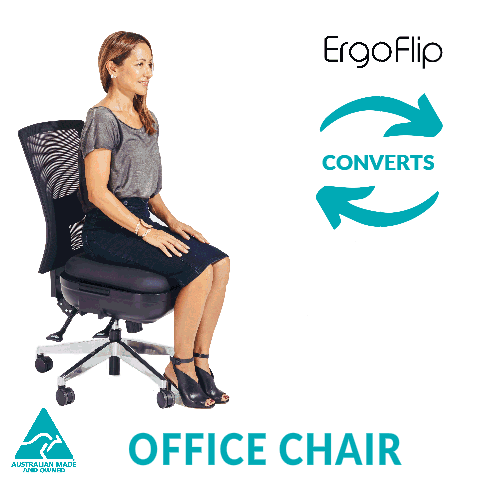
Introducing the revolutionary functional design in active seating, the ErgoFlip, created as the solution to sitting healthy at your desk to help sedentary workers achieve instantaneous mobility to prevent muscular disorders and reduce inactivity.
The ErgoFlip, an Australian made and owned company has engineered an innovative office chair that integrates movement by combining a unique 2 seats in 1 chair that includes a conventional seat and with an effortless flip converts to an active surface boasting the health benefits of a fit ball. The active surface promotes varied postures, increases energy expenditure, strengthens core and back muscles, reduces spinal load and creates blood flow. The ErgoFlip is the first of its kind to offer active sitting with complete ergonomic features with high adjustability (seat height, backrest height, backrest lumbar support, seat surface), to individualise the device for the user.

Supported with a practical workshop, called Improve Your Stamina for Desk Work, was devised to inspire a dynamic, healthy workspace and combat sedentary behaviour in learning how to:
- correctly set up your workstation
- improve posture alignment
- use ergonomic equipment that promotes movement
- take breaks with facilitating movement and exercise
Packaged also with several tutorials on how to sit-active to guide the user on how to maximise the benefits of the chair.
The ErgoFlip comes complete with certifications that comply with Australian standards:
- Australian Physiotherapy Association Endorsed
- TGA Approved
- Australian Made and Owned, Manufactured Nationally in NSW, VIC, QLD & WA
- 10-year manufacturer’s warranty
- Patented and Design Registered
Information supporting the importance of staying active while working at home:
Sedentary workers are feeling the pinch so who is responsible for their wellbeing and safe ergonomics?
According to the World Health Organisation we are now faced with a double pandemic! While of a different nature, the world has been living with another pandemic for a number of years, – physical inactivity (PI) and sedentary behavior (SB). The diseases brought on by inactivity has a whopping price tag for the global economy costing the world $67.bn. Australia shared a huge portion of the cost with the total cost burden of physical inactivity on the Australian economy being $805 million, including $640 million in direct costs and $165 million in productivity losses.
The average Australian spends almost 40 hours per week at work and over 3.7M Australians experience back pain daily, costing $4.8B per year. Fundamentally, more focus must be put on sedentary behaviour in the workplace. Sitting static at a desk all day leads to conditions related to metabolic syndrome, poor posture, spinal disc compression, decreased flexibility, reduced blood flow, stiff joints and tension, lack of energy and loss of productivity.
There is overwhelming clinical evidence that supports that the key to combat sedentary work is regular movement and exercise. Whether exercise can help to reduce the impact of prolonged static sitting, the truth is most of us aren’t doing enough exercise. So we’re being encouraged to try to stand while doing desk work. Don’t try to stand all day, it's not for everyone and can be very tiring but small bouts of movement is important so mixing it up is the key.
This model of 'Disguised fitness' integrated into the workplace, encouraging people to move around more is what some of Australia's biggest companies have adopted including Macquarie Bank, Microsoft and accounting firm KPMG. These OH&S measures can be monitored and controlled whilst at work but what about when workers are at home? What is in place to encourage regular breaks and movement?
Adopting to the new normal, with COVID-19, people are forced to work remotely. With such transitions still currently in place to “flatten the curve” of coronavirus cases, many are forced to adopt such arrangements for the first time. People are now confined and stuck at their desks and they are more than likely sitting on unsuitable seating like dining room chairs and barstools which is another problem the employer will be faced with. Poor ergonomics contributes to muscle strain, imbalances and fatigue resulting in a career of neck and back pain.
Who is responsible for the welfare of the health and safety of 'home workers' to ensure good ergonomics and reduce sedentary behaviour due to lack of inactivity? The model of Work Health & Safety laws still apply at home and employers must provide guidance of what a good workstation set up looks like and how to reduce and avoid sedentary behaviour. This means employers have the responsibility of looking after the health of their workers at home.
ERGOFLIP MADE FOR MOVEMENT

